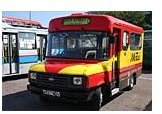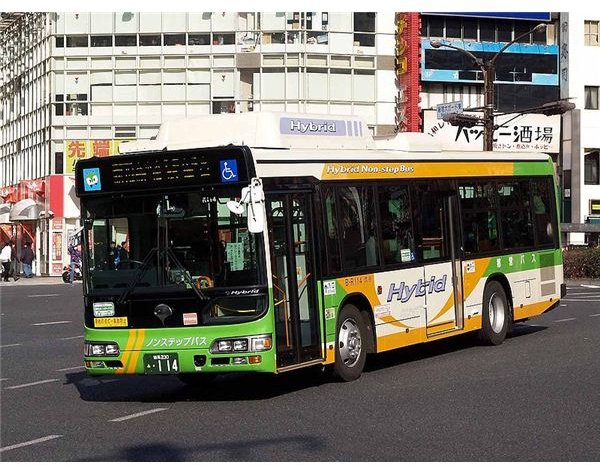About the Hybrid Electric Bus: History of This Eco Friendly, Dual-Powered Public Transportation
About the Hybrid Electric Bus – Overview
It seems that the hybrid electric bus has been around forever, but the reality is that they are only just over 20 years old. Compared to the more traditional buses, their green living approach to eco friendly transportation has allowed cities and towns across the planet to reduce the harmful gas emissions released daily, emissions that are contributing greatly towards global warming. In fact, they are a preferable alternative to both the traditional and electric-only buses because of many factors.
(photo: Blue Ribbon Hybrid bus - reproduced with special permission - Comyu, 2008, CC License 3.0 Unported)
History of Eco Friendly, Dual-Powered Public Transportation
The history of eco friendly, dual-powered public transportation began its life with steam power back in 1769. After a century passed, the drive to power anything by electricity was in full force and by 1839, the world’s first electric boat sailed up the Thames River in London. Electric cars saw their debut in 1870 and electric railways in 1879. By rights, the very first electric type carriages were developed by Magnus Volk for the Turkish Sultan in 1889. From that point, the world saw electric submarines and taxis. However, real hybrid vehicles did not arrive until 1899, when Porsche developed the first hybrid type car. Hybrid buses as we know them today would not materialize completely until the 1980s, when the UK began using dual-powered, hybrid mini buses, testing them as a replacement for the aging double-deckers.

One of the first testing grounds was in the city of Exeter in Devon, England, where locals went to and from work and continued their lives day and night thanks to these amazing, speedy and eco friendly mini, hybrid buses.
The technology of the hybrid bus began to take off as the demand to combat global warming began to influence world governments. The standard mini hybrid bus was replaced with more reliable and larger ones, spreading into New York City in the US and Vancouver in British Columbia, Canada. Today, the advancements are more about fine-tuning services, building extra long buses and making them more convenient, comfortable and easy to use for everyone, including cyclists, wheelchair users and people with strollers and buggies. However, it is the technology behind these hybrid buses that have made them one of the groundbreaking inventions of the 20th century.
(photo: reproduced with permission, Devon General mini bus, Exeter, UK - copyright 1986)
Understanding Hybrid Bus Technology – the Basics
Understanding the basics behind hybrid bus technology isn’t difficult. Put simply, hybrid buses use both an electric type motor and a very small, built-in diesel engine. However, for the majority of the time, the electric motor runs the bus and all of its functions, with the diesel engine only kicking in when the battery is running low on power. Most importantly, many cities and towns that have hybrid buses, have the ability to run them almost 99% of the time on electricity, running only for a short-time on diesel engine power so they can get back to the bus yard to have their batteries recharged.
The Pros and Cons of Dual-Powered Electric Buses
With the advent of dual-powered electric (hybrid) buses, millions were saved annually due to the reduction in fuel consumption alone. The drop in harmful gas emissions alone was staggering, considering that for every three miles alone, carbon monoxide levels dropped as much as 2,262 grams when the diesel alone was being used. This was over 500 grams more than was found on hybrid buses using regular gasoline.
Though many have argued that replacing and charging the huge batteries used by these buses is astoundingly expensive, the reality is that they are far more affordable and cheaper to maintain and refill than any gasoline only-run vehicle or bus. They even far outdo hydrogen cells in cost at present.
Unfortunately, in comparison to traditional buses, the hybrid is more expensive, if nothing more than for the cost of the technology being used. Currently, the basis for using the hybrid buses is based on the long-term cost reduction and the incredible positive impact that they are having on the environment and people’s health. Hybrid buses have been clearly shown to reduce air pollution and thus asthma, cancers, heart attacks and even strokes in many people.
(photo: reproduced with special permission - Stage Coach bus, Exeter, UK - 2005)
The Future of the Hybrid Electric Bus
The future of the hybrid electric bus is an interesting one. As solar power is being improved, the potential for running these buses partially off diesel, solar electricity and standard battery electricity is huge. Even today, scientists and vehicle experts are working closely to ensure that one day that hybrid buses will be the only buses of the future, maybe even replacing the need for private transport during certain times of the day.
Sources:
“The Pros And Cons of Hybrid Buses”, State Journal staff, wire report, WI State Journal, 2005, https://www.busadvocates.org/articles/fuel/hybrid.html
“Trams and buses in Exeter”, David Comforth, online article, 2005-2010, https://www.exetermemories.co.uk/EM/exetertransport.html
“Hybrid History – Part I”, online article, Green Hybrid.Com, 2004, https://www.greenhybrid.com/wiki/index.php/Hybrid_History_-_Part_1
